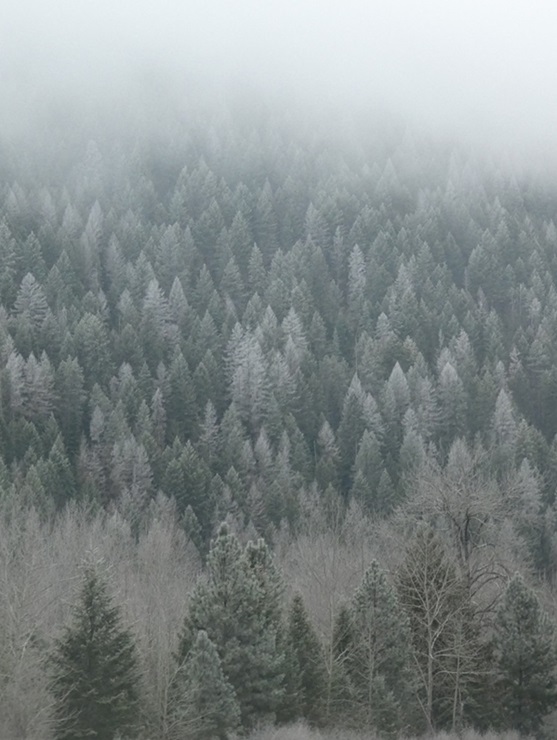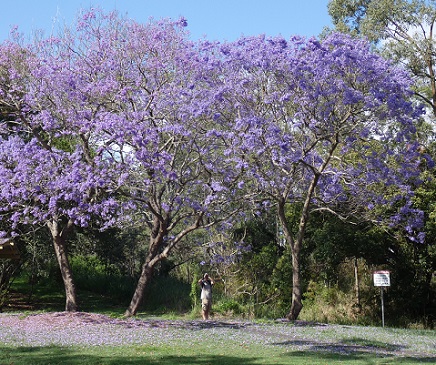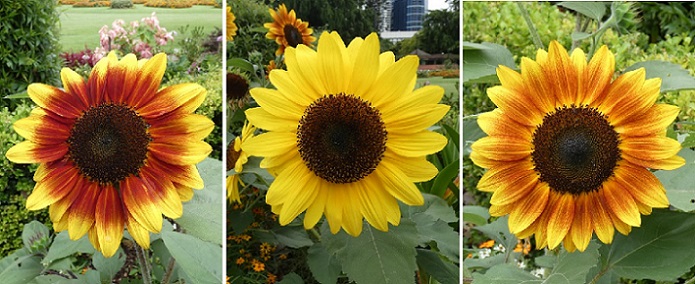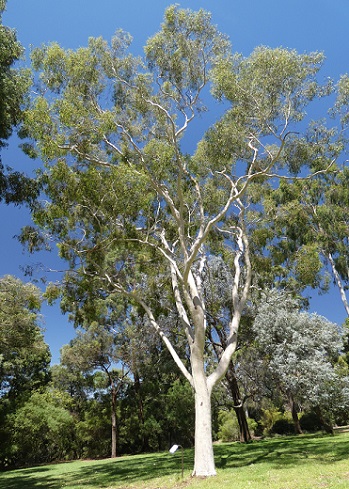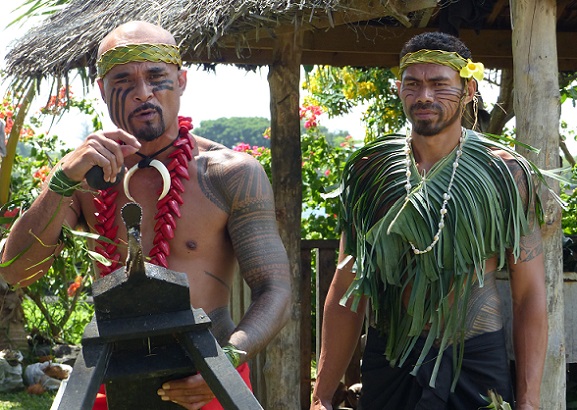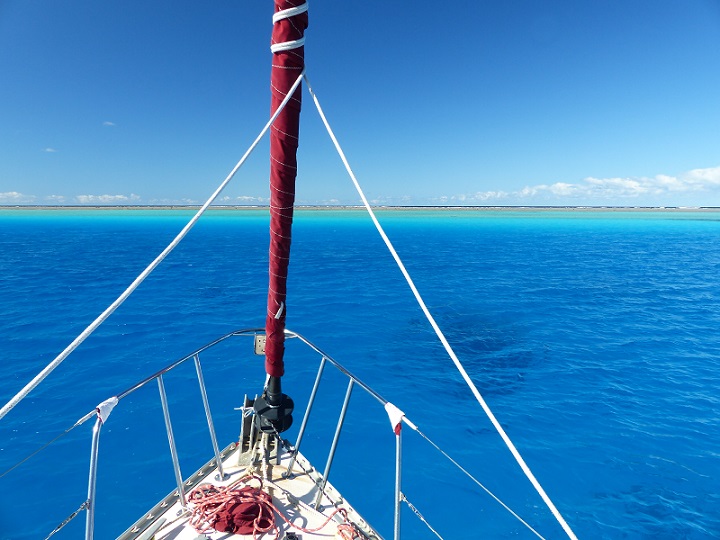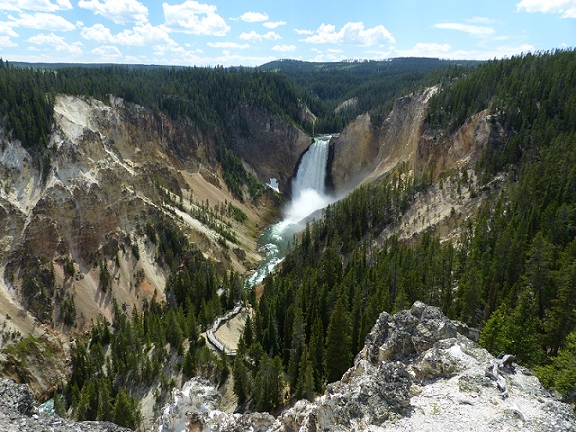
Tregoning
12 April 2024 | We are back aboard Tregoning in Mersin Marina, Mersin, Türkiye
02 April 2024 | We are in Toronto Airport, Canada: Tregoning is in Mersin Marina, Mersin, Türkiye
25 February 2024 | We are back in Gainesville, FL: Tregoning is in Mersin Marina, Mersin, Türkiye
18 February 2024 | We are in Glenwood, New Mexico: Tregoning is in Mersin Marina, Mersin, Türkiye
12 February 2024 | We are in Morro Bay, California: Tregoning is in Mersin Marina, Mersin, Türkiye
19 January 2024 | We are in Vancouver, BC Canada: Tregoning is in Mersin Marina, Mersin, Türkiye
01 January 2024 | We are in Washington State: Tregoning is in Mersin Marina, Mersin, Türkiye
15 December 2023 | We are in Minnesota: Tregoning is in Mersin Marina, Mersin, Türkiye
18 November 2023 | We are in Florida: Tregoning is in Mersin Marina, Mersin, Türkiye
29 October 2023 | We're in Florida - Tregoning is at B-dock, Mersin Marina, Mersin, Türkiye
21 October 2023 | 7 Oda Kapadokya Cave Hotel, Ürgüp, Türkiye
14 October 2023 | Hotel Aşikoğlu, Boğazkale, Türkiye
07 October 2023 | B-dock, Mersin Marina, Mersin, Türkiye
19 September 2023 | “Chez Jon & Angela”, Near Otterton, Devon, UK
14 September 2023 | Airbnb in Fortuneswell on the Isle of Portland, Dorset, UK
11 September 2023 | With Mike, Grange-over-Sands, Cumbria, UK
03 September 2023 | Ardington House, Ardington, Oxfordshire, UK
24 August 2023 | Near "Chez Joan and Peter", College of Roseisle, Moray, Scotland
11 August 2023 | Andrew's house (not exactly), Lichfield, UK
22 July 2023 | Chez Gail, near the New York Café, Budapest, Hungary
Hand-feeding dolphins
11 May 2021 | Off Norman Point, Tin Can Bay, QLD, Australia
Alison Stocker | Photo: A wild Australian humpback dolphin waiting to be fed, next to a program volunteer
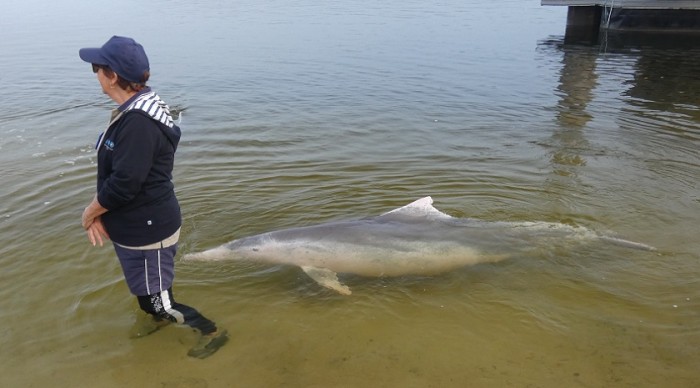
So, where had the names Tin Can Inlet and Tin Can Bay, the small town on the Inlet at the mouth of Snapper Creek, come from?
We assumed that they had resulted from someone marking the area with posts topped by tin cans (or something similar). Instead, Tin Can is probably an anglicized variant of the Aboriginal 'tin-kun' or 'tuncanbar', describing a narrow-leafed coastal vine, or of similar sounding expressions meaning dugong, big fish, or mangroves. The sheltered area has many shallows that are ideal habitat for all of those things, and for the native people who could utilize them.
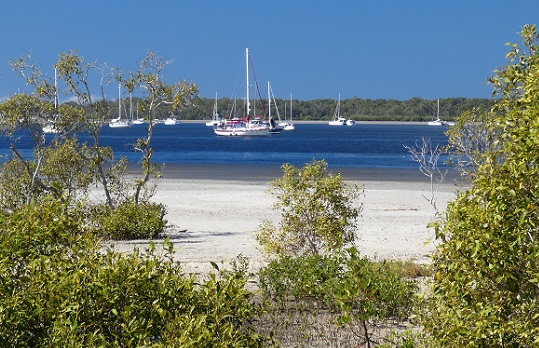
Tregoning (center) anchored in Tin Can Inlet off Tin Can Bay
Late on Monday morning (10th May), we anchored off Norman Point (a.k.a. Snapper Point) where there was ample room between the occupied moorings. With the outboard installed on the dinghy, we rode up Snapper Creek to the Tin Can Bay Marina to look at their fuel dock, then returned to the public dock sandwiched between the boat ramp and Coast Guard station. It pays to be attentive to the navigation marks in this area of the Inlet because the extensive sand-flats that dry out at low tide have steep edges so the water becomes shallow very quickly. These shallows keep boats like ours at a distance from the town (no anchoring is allowed in the mooring-filled Creek), but various flat-bottomed boats happily sit near the shore on dry sand at low tide.
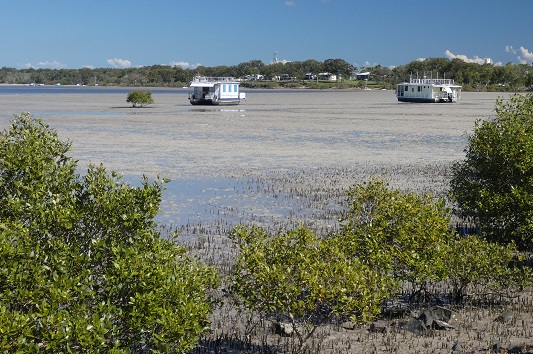
Houseboats on the dried sand-flats by Tin Can Bay at low tide
Tin Can Bay is very pleasant with a long waterfront walk and parks on the Inlet side of Norman Point, and small marinas and commercial fishing-boat docks along Snapper Creek. Inevitably, we wandered along the waterfront walk to have lunch at the Snack Shack which Randall had identified as having good reviews online. It was, indeed, a tasty fish and chips lunch with a huge salad (next night's dinner) and bread and butter!
Walking back to the dinghy dock, we noticed the signs about dolphin-feeding at the neighboring Barnacles Café. We would normally not pay much attention to what we would assume was a commercial enterprise, but this was a volunteer-run program that featured Australian humpback dolphins. We have seen these dolphins briefly and at a great distance in Pelican Bay, but since they do not usually ride the bow-waves of boats, we have never had a close look at one. As a dolphin species with a limited distribution and a species that may spend extended time in rivers or estuaries, our interest was piqued. http://www.barnaclesdolphins.com.au/index.html
It was foggy again the next morning but we were able to see far enough to take the dinghy ashore safely. Arriving at 6:45 am, we were fourth in line for the dolphin feeding at Barnacles Café. Although we both have mixed feelings about this type of interaction with wildlife, this was a program that had origins in the 1950s when an injured dolphin beached itself on the sand in front of the Barnacles Café. Local people took pity on it and started to feed it until it was healed and returned to the open water. It regularly continued to return to the beach for a free meal. Second and third generation dolphins have become regulars at the beach including another injured dolphin that was tended by volunteers for 10 days before being able to fend for itself again. In total, nine dolphins in the local pod, of both genders and various ages, are recognized as making frequent visits for feeding.
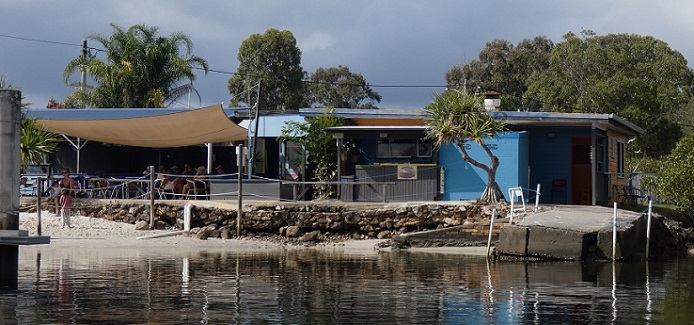
The tiny sand beach outside Barnacles Café where the dolphin feeding occurs
Exactly when and how this informal interaction with the dolphins became regulated is not obvious. The current program is run by volunteers and is monitored by the Queensland Government's Environmental, Heritage and Protection Department. The A$10 fee to be involved in the feeding activity goes to pay for the fish and perhaps volunteer uniforms, etc. Whether the café receives any of that money or simply benefits from the attraction of potential patrons was not evident.
This is the only permitted program for feeding Australian humpback dolphins in Australia and we got the impression that it is being well-regulated and managed. Each dolphin is only fed up to 3 kg (6.6 lbs) a day, out of a daily diet of 15 kg (33 lbs), ensuring that these animals must still hunt for most of their food and could survive if the feeding program stopped. There are many volunteers who rotate through the daily programs and nobody can enter the water without a volunteer present. It is acceptable if the dolphins touches you, but nobody can swim with or touch the dolphins (including the volunteers even if they are being persistently nudged). Only the appropriate fish that are provided can be fed to the dolphins and everyone must wash their hands with a suitable antibacterial solution before handling the fish. The program emphasized that it is illegal to feed wild dolphins under any other circumstances and must not be done, however tempting. The volunteers also reminded us that the water is the dolphins' home and any pollution or littering is potentially harmful.
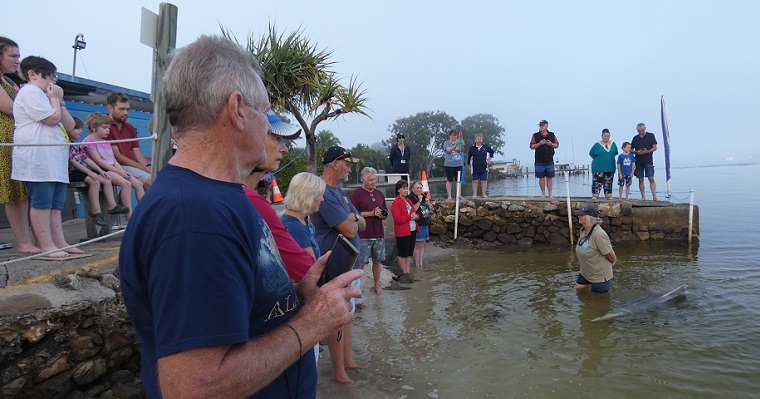
The volunteer must be careful not to reach out to touch the dolphin while our group stands at the edge of the water listening to the educational program
The Australian humpback dolphin, Sousa sahulersis, was only recognized as a separate species from the Indo-Pacific humpback dolphin in 2014. The two other species of humpback dolphin, the Indian Ocean humpback and the Atlantic humpback, have much more prominent humps of fatty tissue under their dorsal fins. The distribution of the Australian humpback is along the northern east and west coasts of Australia to southern New Guinea, with the Tin Can Bay population being at the southern edge of its range. Not known to be migratory, their preferred habitat is water less than 20 m deep (66 feet) in coastal and estuarine areas of tropical and sub-tropical regions. There is no formal population estimate but it may be "a few thousand".
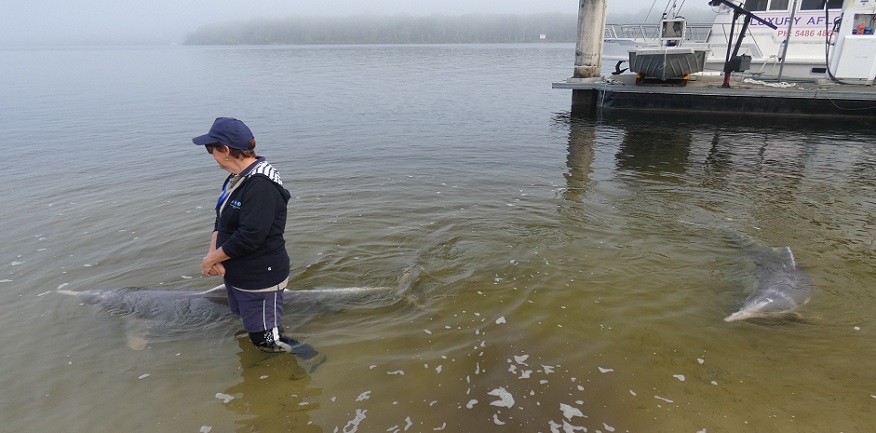
Australian humpback dolphins Ella and Patch swim patiently around a volunteer while waiting for feeding time
Australian Humpback dolphins have a longer beak than most other dolphins, including bottlenose dolphins, and their dorsal fin is elongated. Growing up to 2.7m long (9 feet) and 180 kg (400 lb), they reach physical maturity around 14 years old and can live to around 40 years of age. Calves are about 1 m in length and 13 kg at birth (3 feet, 29 lbs) and are grey in color. Their skin, particularly around the dorsal fin and head, pales with age, often becoming quite pink.
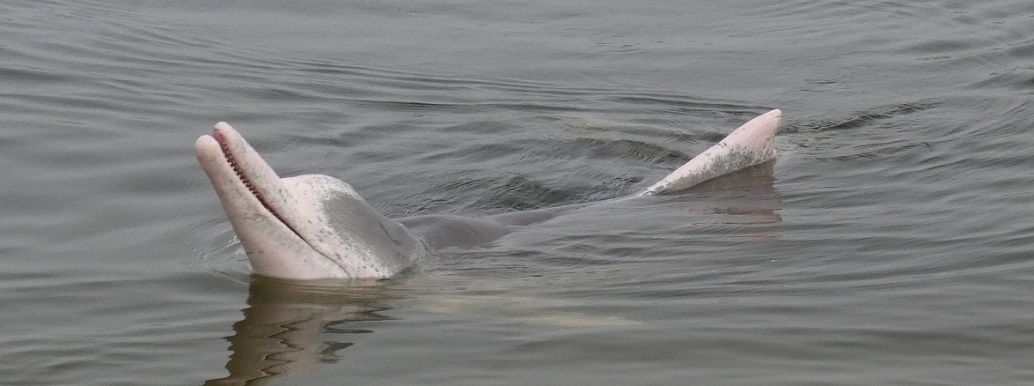
Patch 'social blushing'; a behavior performed by dominant males
Australian humpback dolphins rarely exhibit aerial displays and have a leisurely cruising speed of 4 knots with a top speed of 11 knots. They usually swim in pods of around five animals lead by an alpha male, or occasionally an alpha female. Their prey includes fish, prawns, mollusks, crabs, squid, and octopus. Males will fight for territory or access to females but their greatest risk, other than from humans, is being drowned by bull sharks. Sadly, entrapment in nets, pollution, overfishing, habitat loss and degradation (including from climate change), and vessel strikes are among the usual suspects of human-caused threats.
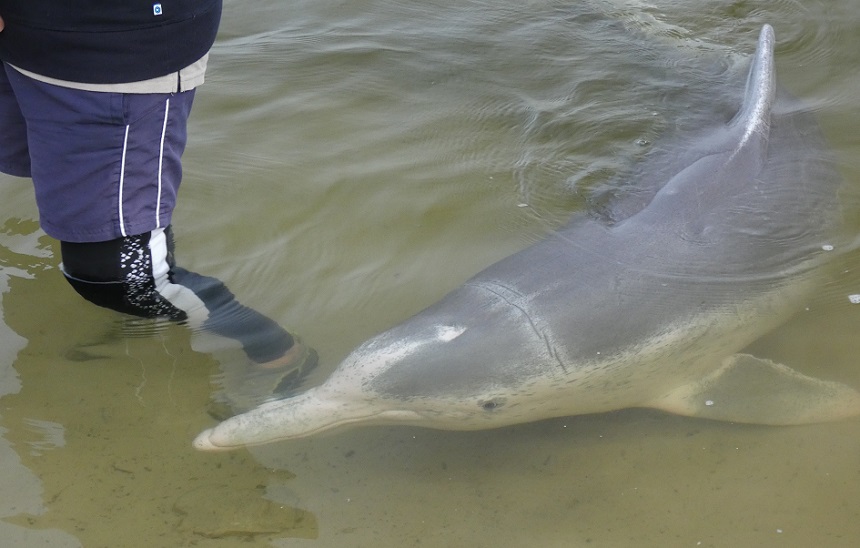
Ella stays close to the volunteer while waiting for feeding time
Before we were allowed on the beach, it was raked below and above the waterline to make sure that nothing dangerous was hidden in the sand that could hurt the dolphins or the bare-footed visitors. Once the program started after 7 am, groups of people were allowed to stand at the water's edge for a close view as a pair of dolphins swam around the legs of two volunteers who talked about the dolphins for about 45 minutes. With around 60 visitors, we were divided into three groups for this part of the program. There is no guarantee that any dolphins will appear (in which case the A$10 is refunded) but usually at least one shows up. Because of the limit of 3 kg on the amount of fish that any dolphin is allowed, on a given day only enough tickets are only sold to cover the number of fish available for feeding. Apparently, 6 kg (for the two dolphins) includes about 60 fish because it appeared that everyone had a chance to be involved in this feeding.
This occurs at the end of the program, after an official tape-recording is played (which is presumably part of the conditions of the operations permit) which repeats much of what the volunteers have already told us. At this point, a feeding station is established for each dolphin (a volunteer with the appropriately labelled bucket of fish).
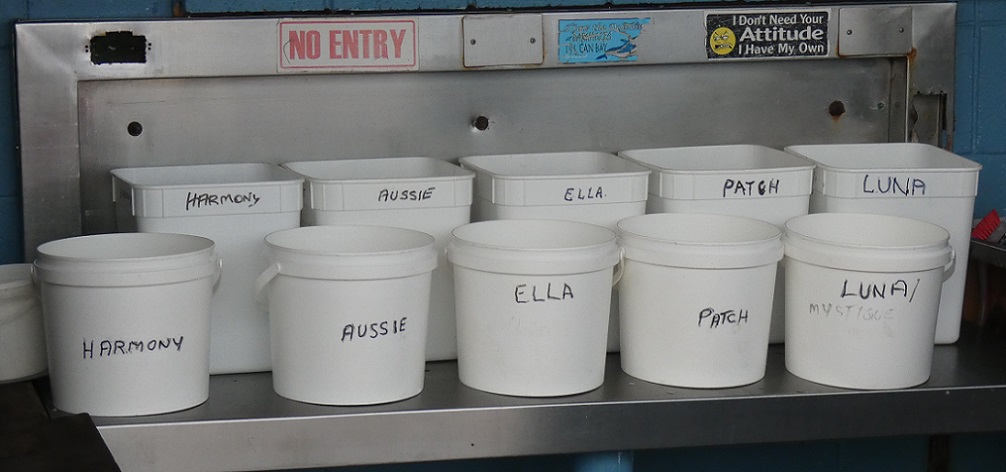
Buckets for 3 kg of fish for each of the dolphins that regularly attend the feedings
Individuals or family groups are then invited down to a feeding station. Typically, while one person takes pictures, another is instructed to hold the fish flat on their hand at the water surface, just in front of the dolphin which has learned to wait patiently beside the volunteer.
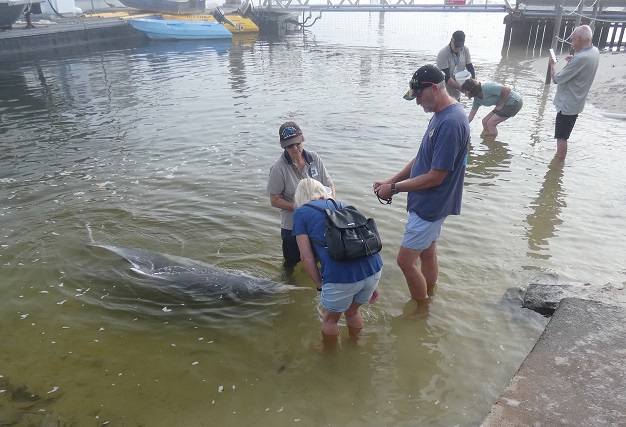
Couples at the two feeding stations
The dolphin quickly and delicately moves forward to take the fish then moves back again while it eats it. The roles are reversed until each person in the family group has hand-fed one fish and then they leave. Then the next group is invited to the feeding station and so on until all of the people or fish are gone. Once the dolphins are shown the empty bucket, they know the program is over and off they go.
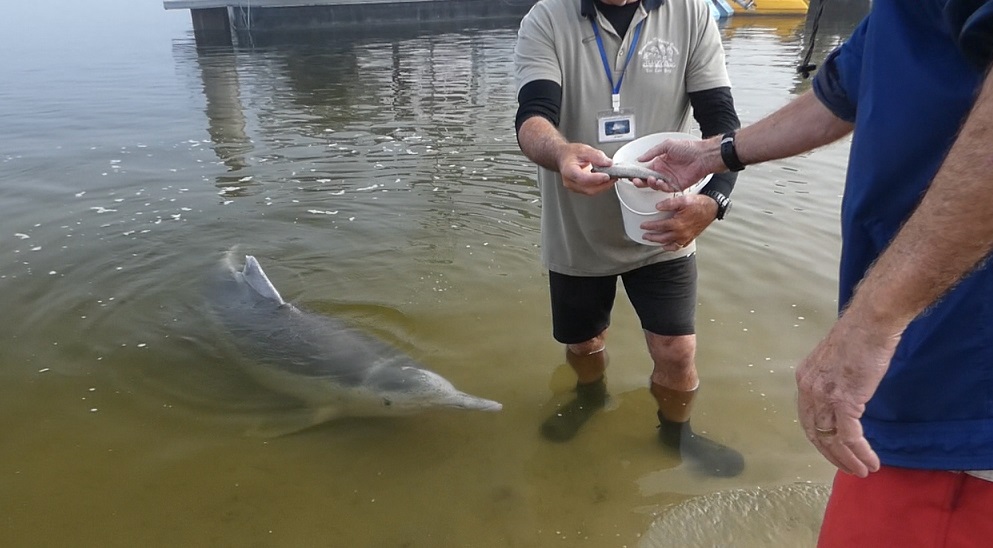
Ella waits patiently as Randall is given his fish
The moment of taking the proffered fish was over quickly, so it was recommended video rather than still pictures be taken. In our excitement, we managed to mess-up the camera setting with the video off when we thought it was on, and on when we thought it was off. So we have a nice recording of passing video from one person to the other but no actual feeding of the dolphin!

Ella munches her fish as Randall withdraws his hand (and I missed recording the actual moment of feeding)
We felt that the program was professionally run and very educational but are we just rationalizing questionable behavior? We had been through this soul-searching when we snorkeled with the humpback whales in Tonga. In that case, the whales did not voluntarily show-up for the interaction, on the other hand, food was not on offer and the whales could have swam away from us at any time. The following section summarizes some of the discussion that Randall and I had following the hand-feeding experience at Tin Can Bay. We did not search the doubtless extensive research on this topic of human/wildlife interactions. We will leave that to a more academic setting. If you would rather skip this attempted moralizing, scroll down to the next photo.
What is so attractive about interactions with wildlife that include feeding?
1. Close proximity
This was probably our primary motivation and we would have been almost as satisfied if only the volunteers fed the dolphins in our presence. This is probably a reason why sites where people can get close to watch wild animals feeding naturally, such as grizzly bears on salmon runs, are so popular. It is also why most people put their bird-feeders where they can see them.
2. Feeling trusted or in control
Hand-feeding allows people to feel that an animal trusts them and is not terrified of them which is a satisfying emotion. An animal that trusts you may be perceived as a better judge of you than other humans ("If my dog trusts you, so do I"). Some people, especially young children, are satisfied by the sense of control that hand-feeding implies, "I am getting this animal to do what I want and come to me".
3. Bucket-list photo-opportunity
Beyond just the benefit of proximity, this is "collecting" evidence of you doing something unusual with wildlife.
4. Feeling of "doing good"
If the animals are perceived to be in need, then feeding satisfies the desire to help them. This might be the primary motivator if your bird-feeder is positioned somewhere out-of-sight.
What are some of the issues related to feeding interactions?
1. Danger to humans
Encouraging wild animals to lose their fear of humans can present problems at the site of feeding if the animals may act unpredictably and aggressively. Off-site issues occur when animals assume that other humans have food and act aggressively if none is offered. Someone perceptively asked whether these dolphins approach people on other beaches hoping for food. The volunteers had once heard of dolphins approaching people at Inskip Point. Fortunately, dolphins are sufficiently intelligent to distinguish between likely and unlikely feeding events and left quickly. It is to be hoped that people so approached do not try to feed dolphins, especially if they only have inappropriate food available. On Fraser Island, where no feeding of dingoes is allowed at all, there have been two recent attacks on very young children that are likely the result of other people having illegally fed dingoes and reducing their fear of approaching people.
2. Danger to the wild animals
At the feeding site, animals may be exposed to diseases carried by humans or the food on offer. In unregulated feeding, inappropriate, unhealthy food may be offered.
Both at the feeding sites and if the animals become generally less fearful of humans, they may be more likely to be exposed to injury or death from vehicles, poachers/hunters, or predators that learn that their prey become concentrated in such areas.
3. Making the animals dependent on the interaction
If too much of the animals' diet is being provided by feeding, they may lose their ability (especially in young, inexperienced animals) or incentive to self-feed. Thus, if the feeding stops suddenly, these animals may struggle to feed themselves. This was why no more than one fifth of the typical daily diet of the dolphins was provided at the feeding station. Another issue if the feeding stops suddenly, is that it may have allowed the animal population to exceed the carrying-capacity of the habitat, causing intense competition. Of course, this is exactly the intention of encouraging the use of urban bird-feeders where there has been much loss of natural habitat.
4. Creating artificial feeding points
This can have a negative effect on social behavior if, for example, dominant animals become more aggressive to others where food is concentrated. Is it possible that migration patterns can be disrupted? Can unintended feeding of birds such as geese in agricultural areas or extensive lawns, change behaviors that are learned or inherited by subsequent generations? Perhaps I'm digressing too far from hand-feeding wildlife?
5. Education of people
In this instance, the educational value of this feeding program for a little-known species of dolphin seemed to have high potential benefits. The harder question to answer is whether such feeding of wildlife discourages illegal, unregulated feeding because that message was-well emphasized during the program and on the website and literature associated with it. Or does the publicity of this sort of activity promulgate a broader message that is it OK to feed wildlife, whether the same or any species? Unfortunately, it seems that the most likely people to justify their own illegal feeding of wildlife, might be among the least likely to attend a regulated feeding and, hence, would miss the message to NOT feed wildlife at any other time or place. Do such regulated programs in a nation like Australia encourage unregulated and potentially harmful programs in other countries?
These are complex issues and undoubtedly vary with different species and types of feeding program. Seeing such wild animals so closely in part of their habitat is much more exciting than viewing them in a zoo or aquarium. It seems better for the individual animals too. Humans have been feeding wild animals for one reason or another forever, so is a program like this about as good as it gets? How could we do better? Or should this type of artificial interaction with wildlife be stopped? I suppose that we have to make our own decisions on how we feel about this, and inform regulators accordingly.
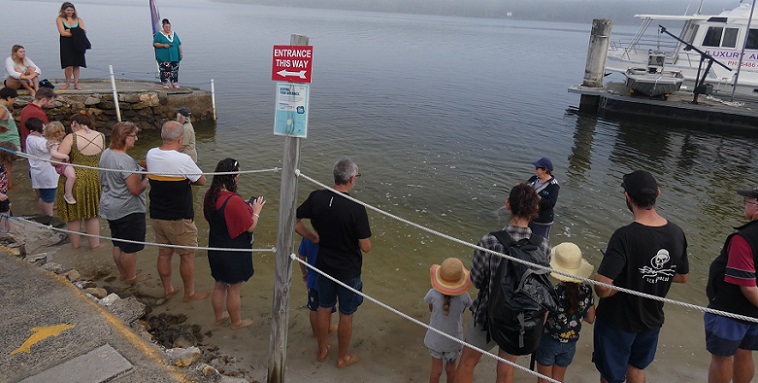
Listening to the volunteers describe the Australian humpback dolphins - the family of SV Sweetpea are on the right
We recognized one of the family groups at Barnacles Café as the crew aboard SV Sweetpea. We had first met them at The Boat Works where they were getting their boat ready for their first experience of cruising. An enthusiastic couple with two young daughters, they had undergone a bit of a baptism of fire to the cruising lifestyle, when their first experience of crossing a river bar was to come across Wide Bay Bar in the fog! If that had rattled them, they did not show it now but were very happy to be able to hand-feed a dolphin. Randall chatted with them in one of the parks overlooking the Inlet while waiting for me to run all the way along the waterfront trail and back down the main street of Tin Can Bay. We also completed a quick bird survey (part done while I was running and part afterwards), then had breakfast at Barnacles Café around 10 am.
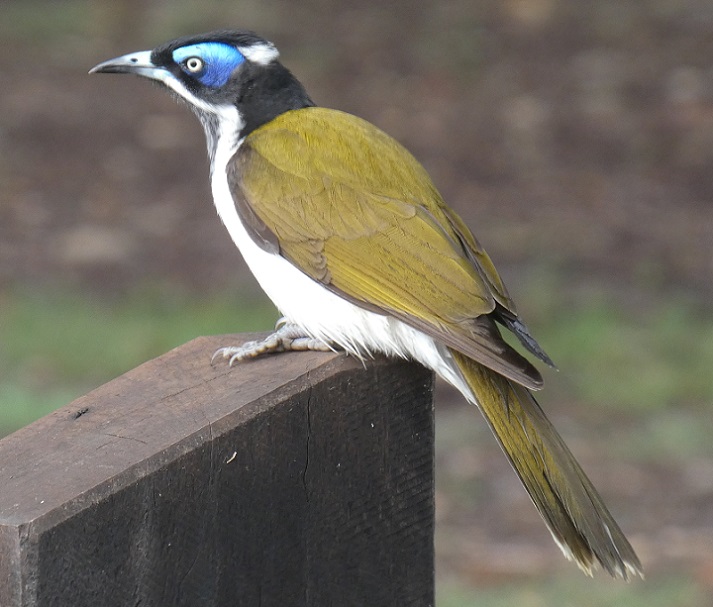
Blue-faced honeyeater (up to 30 cm or 12 inches)
While eating, I noticed a few people moving over to the small beach so I joined them to see two Australian humpback dolphins briefly came to shore. Not the same adults that came to the feeding but this pair was smaller, and much greyer so probably considerably younger.

Pair of younger Australian humpback dolphins that visited Barnacles Café late-morning
They may have come close to the shore because a young woman and her two small children were sitting and paddling (wading) on the beach. The owner of the Café quickly came out and told them that the beach was closed and they should not have crossed the rope cordon to get onto it. With the dolphins right in front of him, it took quite a bit of persuading to get the little boy to come out of the water, he was clearly so tempted to walk out and try to touch them. The proprietor was quite emphatic that she was at risk of losing her permit if such behavior were seen by an inspector, so that the grumbling mother finally got both her children off the sand. The dolphins swam away as soon as they realized that no one was coming to feed them. It was a brief but probably not uncommon incident. It provided a telling illustration of how complex human-wildlife interactions can be and how easily an unintended breaking of the carefully developed rules can occur.
P.S. After posting this, my dear friend Linda in Gainesville pointed out this timely article on the topic of ‘provisioning’ wildlife in the New York Times: The Price They Pay for Your Perfect Vacation Photo
https://www.nytimes.com/2021/05/11/science/tourists-turtles-sharks-photography.html?referringSource=articleShare
We assumed that they had resulted from someone marking the area with posts topped by tin cans (or something similar). Instead, Tin Can is probably an anglicized variant of the Aboriginal 'tin-kun' or 'tuncanbar', describing a narrow-leafed coastal vine, or of similar sounding expressions meaning dugong, big fish, or mangroves. The sheltered area has many shallows that are ideal habitat for all of those things, and for the native people who could utilize them.

Tregoning (center) anchored in Tin Can Inlet off Tin Can Bay
Late on Monday morning (10th May), we anchored off Norman Point (a.k.a. Snapper Point) where there was ample room between the occupied moorings. With the outboard installed on the dinghy, we rode up Snapper Creek to the Tin Can Bay Marina to look at their fuel dock, then returned to the public dock sandwiched between the boat ramp and Coast Guard station. It pays to be attentive to the navigation marks in this area of the Inlet because the extensive sand-flats that dry out at low tide have steep edges so the water becomes shallow very quickly. These shallows keep boats like ours at a distance from the town (no anchoring is allowed in the mooring-filled Creek), but various flat-bottomed boats happily sit near the shore on dry sand at low tide.

Houseboats on the dried sand-flats by Tin Can Bay at low tide
Tin Can Bay is very pleasant with a long waterfront walk and parks on the Inlet side of Norman Point, and small marinas and commercial fishing-boat docks along Snapper Creek. Inevitably, we wandered along the waterfront walk to have lunch at the Snack Shack which Randall had identified as having good reviews online. It was, indeed, a tasty fish and chips lunch with a huge salad (next night's dinner) and bread and butter!
Walking back to the dinghy dock, we noticed the signs about dolphin-feeding at the neighboring Barnacles Café. We would normally not pay much attention to what we would assume was a commercial enterprise, but this was a volunteer-run program that featured Australian humpback dolphins. We have seen these dolphins briefly and at a great distance in Pelican Bay, but since they do not usually ride the bow-waves of boats, we have never had a close look at one. As a dolphin species with a limited distribution and a species that may spend extended time in rivers or estuaries, our interest was piqued. http://www.barnaclesdolphins.com.au/index.html
It was foggy again the next morning but we were able to see far enough to take the dinghy ashore safely. Arriving at 6:45 am, we were fourth in line for the dolphin feeding at Barnacles Café. Although we both have mixed feelings about this type of interaction with wildlife, this was a program that had origins in the 1950s when an injured dolphin beached itself on the sand in front of the Barnacles Café. Local people took pity on it and started to feed it until it was healed and returned to the open water. It regularly continued to return to the beach for a free meal. Second and third generation dolphins have become regulars at the beach including another injured dolphin that was tended by volunteers for 10 days before being able to fend for itself again. In total, nine dolphins in the local pod, of both genders and various ages, are recognized as making frequent visits for feeding.

The tiny sand beach outside Barnacles Café where the dolphin feeding occurs
Exactly when and how this informal interaction with the dolphins became regulated is not obvious. The current program is run by volunteers and is monitored by the Queensland Government's Environmental, Heritage and Protection Department. The A$10 fee to be involved in the feeding activity goes to pay for the fish and perhaps volunteer uniforms, etc. Whether the café receives any of that money or simply benefits from the attraction of potential patrons was not evident.
This is the only permitted program for feeding Australian humpback dolphins in Australia and we got the impression that it is being well-regulated and managed. Each dolphin is only fed up to 3 kg (6.6 lbs) a day, out of a daily diet of 15 kg (33 lbs), ensuring that these animals must still hunt for most of their food and could survive if the feeding program stopped. There are many volunteers who rotate through the daily programs and nobody can enter the water without a volunteer present. It is acceptable if the dolphins touches you, but nobody can swim with or touch the dolphins (including the volunteers even if they are being persistently nudged). Only the appropriate fish that are provided can be fed to the dolphins and everyone must wash their hands with a suitable antibacterial solution before handling the fish. The program emphasized that it is illegal to feed wild dolphins under any other circumstances and must not be done, however tempting. The volunteers also reminded us that the water is the dolphins' home and any pollution or littering is potentially harmful.

The volunteer must be careful not to reach out to touch the dolphin while our group stands at the edge of the water listening to the educational program
The Australian humpback dolphin, Sousa sahulersis, was only recognized as a separate species from the Indo-Pacific humpback dolphin in 2014. The two other species of humpback dolphin, the Indian Ocean humpback and the Atlantic humpback, have much more prominent humps of fatty tissue under their dorsal fins. The distribution of the Australian humpback is along the northern east and west coasts of Australia to southern New Guinea, with the Tin Can Bay population being at the southern edge of its range. Not known to be migratory, their preferred habitat is water less than 20 m deep (66 feet) in coastal and estuarine areas of tropical and sub-tropical regions. There is no formal population estimate but it may be "a few thousand".

Australian humpback dolphins Ella and Patch swim patiently around a volunteer while waiting for feeding time
Australian Humpback dolphins have a longer beak than most other dolphins, including bottlenose dolphins, and their dorsal fin is elongated. Growing up to 2.7m long (9 feet) and 180 kg (400 lb), they reach physical maturity around 14 years old and can live to around 40 years of age. Calves are about 1 m in length and 13 kg at birth (3 feet, 29 lbs) and are grey in color. Their skin, particularly around the dorsal fin and head, pales with age, often becoming quite pink.

Patch 'social blushing'; a behavior performed by dominant males
Australian humpback dolphins rarely exhibit aerial displays and have a leisurely cruising speed of 4 knots with a top speed of 11 knots. They usually swim in pods of around five animals lead by an alpha male, or occasionally an alpha female. Their prey includes fish, prawns, mollusks, crabs, squid, and octopus. Males will fight for territory or access to females but their greatest risk, other than from humans, is being drowned by bull sharks. Sadly, entrapment in nets, pollution, overfishing, habitat loss and degradation (including from climate change), and vessel strikes are among the usual suspects of human-caused threats.

Ella stays close to the volunteer while waiting for feeding time
Before we were allowed on the beach, it was raked below and above the waterline to make sure that nothing dangerous was hidden in the sand that could hurt the dolphins or the bare-footed visitors. Once the program started after 7 am, groups of people were allowed to stand at the water's edge for a close view as a pair of dolphins swam around the legs of two volunteers who talked about the dolphins for about 45 minutes. With around 60 visitors, we were divided into three groups for this part of the program. There is no guarantee that any dolphins will appear (in which case the A$10 is refunded) but usually at least one shows up. Because of the limit of 3 kg on the amount of fish that any dolphin is allowed, on a given day only enough tickets are only sold to cover the number of fish available for feeding. Apparently, 6 kg (for the two dolphins) includes about 60 fish because it appeared that everyone had a chance to be involved in this feeding.
This occurs at the end of the program, after an official tape-recording is played (which is presumably part of the conditions of the operations permit) which repeats much of what the volunteers have already told us. At this point, a feeding station is established for each dolphin (a volunteer with the appropriately labelled bucket of fish).

Buckets for 3 kg of fish for each of the dolphins that regularly attend the feedings
Individuals or family groups are then invited down to a feeding station. Typically, while one person takes pictures, another is instructed to hold the fish flat on their hand at the water surface, just in front of the dolphin which has learned to wait patiently beside the volunteer.

Couples at the two feeding stations
The dolphin quickly and delicately moves forward to take the fish then moves back again while it eats it. The roles are reversed until each person in the family group has hand-fed one fish and then they leave. Then the next group is invited to the feeding station and so on until all of the people or fish are gone. Once the dolphins are shown the empty bucket, they know the program is over and off they go.

Ella waits patiently as Randall is given his fish
The moment of taking the proffered fish was over quickly, so it was recommended video rather than still pictures be taken. In our excitement, we managed to mess-up the camera setting with the video off when we thought it was on, and on when we thought it was off. So we have a nice recording of passing video from one person to the other but no actual feeding of the dolphin!

Ella munches her fish as Randall withdraws his hand (and I missed recording the actual moment of feeding)
We felt that the program was professionally run and very educational but are we just rationalizing questionable behavior? We had been through this soul-searching when we snorkeled with the humpback whales in Tonga. In that case, the whales did not voluntarily show-up for the interaction, on the other hand, food was not on offer and the whales could have swam away from us at any time. The following section summarizes some of the discussion that Randall and I had following the hand-feeding experience at Tin Can Bay. We did not search the doubtless extensive research on this topic of human/wildlife interactions. We will leave that to a more academic setting. If you would rather skip this attempted moralizing, scroll down to the next photo.
What is so attractive about interactions with wildlife that include feeding?
1. Close proximity
This was probably our primary motivation and we would have been almost as satisfied if only the volunteers fed the dolphins in our presence. This is probably a reason why sites where people can get close to watch wild animals feeding naturally, such as grizzly bears on salmon runs, are so popular. It is also why most people put their bird-feeders where they can see them.
2. Feeling trusted or in control
Hand-feeding allows people to feel that an animal trusts them and is not terrified of them which is a satisfying emotion. An animal that trusts you may be perceived as a better judge of you than other humans ("If my dog trusts you, so do I"). Some people, especially young children, are satisfied by the sense of control that hand-feeding implies, "I am getting this animal to do what I want and come to me".
3. Bucket-list photo-opportunity
Beyond just the benefit of proximity, this is "collecting" evidence of you doing something unusual with wildlife.
4. Feeling of "doing good"
If the animals are perceived to be in need, then feeding satisfies the desire to help them. This might be the primary motivator if your bird-feeder is positioned somewhere out-of-sight.
What are some of the issues related to feeding interactions?
1. Danger to humans
Encouraging wild animals to lose their fear of humans can present problems at the site of feeding if the animals may act unpredictably and aggressively. Off-site issues occur when animals assume that other humans have food and act aggressively if none is offered. Someone perceptively asked whether these dolphins approach people on other beaches hoping for food. The volunteers had once heard of dolphins approaching people at Inskip Point. Fortunately, dolphins are sufficiently intelligent to distinguish between likely and unlikely feeding events and left quickly. It is to be hoped that people so approached do not try to feed dolphins, especially if they only have inappropriate food available. On Fraser Island, where no feeding of dingoes is allowed at all, there have been two recent attacks on very young children that are likely the result of other people having illegally fed dingoes and reducing their fear of approaching people.
2. Danger to the wild animals
At the feeding site, animals may be exposed to diseases carried by humans or the food on offer. In unregulated feeding, inappropriate, unhealthy food may be offered.
Both at the feeding sites and if the animals become generally less fearful of humans, they may be more likely to be exposed to injury or death from vehicles, poachers/hunters, or predators that learn that their prey become concentrated in such areas.
3. Making the animals dependent on the interaction
If too much of the animals' diet is being provided by feeding, they may lose their ability (especially in young, inexperienced animals) or incentive to self-feed. Thus, if the feeding stops suddenly, these animals may struggle to feed themselves. This was why no more than one fifth of the typical daily diet of the dolphins was provided at the feeding station. Another issue if the feeding stops suddenly, is that it may have allowed the animal population to exceed the carrying-capacity of the habitat, causing intense competition. Of course, this is exactly the intention of encouraging the use of urban bird-feeders where there has been much loss of natural habitat.
4. Creating artificial feeding points
This can have a negative effect on social behavior if, for example, dominant animals become more aggressive to others where food is concentrated. Is it possible that migration patterns can be disrupted? Can unintended feeding of birds such as geese in agricultural areas or extensive lawns, change behaviors that are learned or inherited by subsequent generations? Perhaps I'm digressing too far from hand-feeding wildlife?
5. Education of people
In this instance, the educational value of this feeding program for a little-known species of dolphin seemed to have high potential benefits. The harder question to answer is whether such feeding of wildlife discourages illegal, unregulated feeding because that message was-well emphasized during the program and on the website and literature associated with it. Or does the publicity of this sort of activity promulgate a broader message that is it OK to feed wildlife, whether the same or any species? Unfortunately, it seems that the most likely people to justify their own illegal feeding of wildlife, might be among the least likely to attend a regulated feeding and, hence, would miss the message to NOT feed wildlife at any other time or place. Do such regulated programs in a nation like Australia encourage unregulated and potentially harmful programs in other countries?
These are complex issues and undoubtedly vary with different species and types of feeding program. Seeing such wild animals so closely in part of their habitat is much more exciting than viewing them in a zoo or aquarium. It seems better for the individual animals too. Humans have been feeding wild animals for one reason or another forever, so is a program like this about as good as it gets? How could we do better? Or should this type of artificial interaction with wildlife be stopped? I suppose that we have to make our own decisions on how we feel about this, and inform regulators accordingly.

Listening to the volunteers describe the Australian humpback dolphins - the family of SV Sweetpea are on the right
We recognized one of the family groups at Barnacles Café as the crew aboard SV Sweetpea. We had first met them at The Boat Works where they were getting their boat ready for their first experience of cruising. An enthusiastic couple with two young daughters, they had undergone a bit of a baptism of fire to the cruising lifestyle, when their first experience of crossing a river bar was to come across Wide Bay Bar in the fog! If that had rattled them, they did not show it now but were very happy to be able to hand-feed a dolphin. Randall chatted with them in one of the parks overlooking the Inlet while waiting for me to run all the way along the waterfront trail and back down the main street of Tin Can Bay. We also completed a quick bird survey (part done while I was running and part afterwards), then had breakfast at Barnacles Café around 10 am.

Blue-faced honeyeater (up to 30 cm or 12 inches)
While eating, I noticed a few people moving over to the small beach so I joined them to see two Australian humpback dolphins briefly came to shore. Not the same adults that came to the feeding but this pair was smaller, and much greyer so probably considerably younger.

Pair of younger Australian humpback dolphins that visited Barnacles Café late-morning
They may have come close to the shore because a young woman and her two small children were sitting and paddling (wading) on the beach. The owner of the Café quickly came out and told them that the beach was closed and they should not have crossed the rope cordon to get onto it. With the dolphins right in front of him, it took quite a bit of persuading to get the little boy to come out of the water, he was clearly so tempted to walk out and try to touch them. The proprietor was quite emphatic that she was at risk of losing her permit if such behavior were seen by an inspector, so that the grumbling mother finally got both her children off the sand. The dolphins swam away as soon as they realized that no one was coming to feed them. It was a brief but probably not uncommon incident. It provided a telling illustration of how complex human-wildlife interactions can be and how easily an unintended breaking of the carefully developed rules can occur.
P.S. After posting this, my dear friend Linda in Gainesville pointed out this timely article on the topic of ‘provisioning’ wildlife in the New York Times: The Price They Pay for Your Perfect Vacation Photo
https://www.nytimes.com/2021/05/11/science/tourists-turtles-sharks-photography.html?referringSource=articleShare
Comments
| Vessel Name: | Tregoning |
| Vessel Make/Model: | Morgan Classic 41 |
| Hailing Port: | Gainesville, FL |
| Crew: | Alison and Randall |
| About: | We cast-off from Fernandina Beach in north Florida on 1st June 2008 and we have been cruising on Tregoning ever since. Before buying Tregoning, both of us had been sailing on smaller boats for many years and had worked around boats and water throughout our careers. |
| Extra: | “Tregoning” (rhymes with “belonging”) and is a Cornish word (meaning “homestead of Cohnan” or “farm by the ash trees”) and was Alison's mother’s middle name. Cornwall is in southwest England and is where Alison grew-up. |
Tregoning's Photos - Main
 |
Extra photographs from our three-week campervan tour of the South Island from November 15th to December 5th 2015
217 Photos
Created 4 January 2016
|
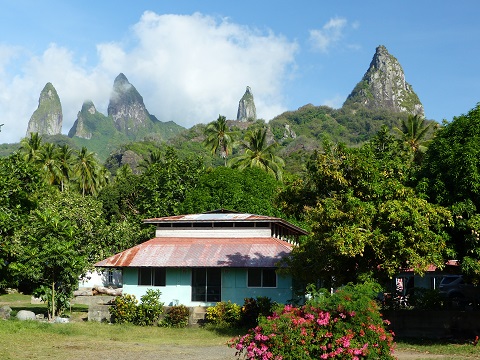 |
Random pictures from our month spent on the islands of Hiva Oa, Tahuata, Ua Pou, and Nuku Hiva
45 Photos
Created 18 July 2015
|
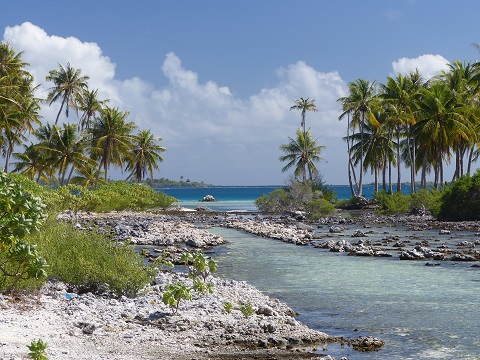 |
Random pictures from our month spent in 4 Tuamotu Atolls; Ahe, Fakarava, Tahanea, and Toau
32 Photos
Created 1 July 2015
|
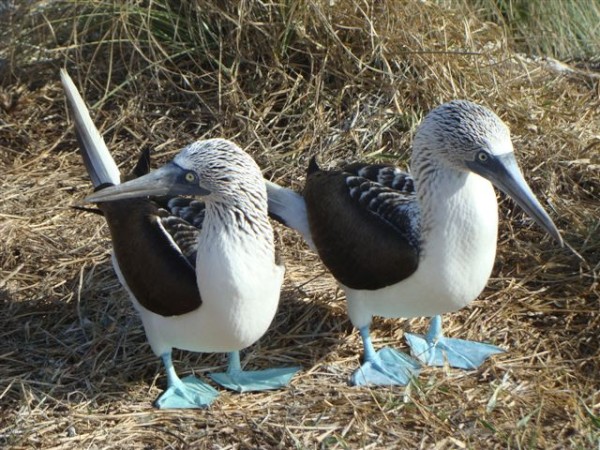 |
Some of the birds, fish, reptiles, and mammals (and others) that we have seen in Mexico
74 Photos
Created 5 May 2014
|
Tregoning

Who: Alison and Randall
Port: Gainesville, FL
